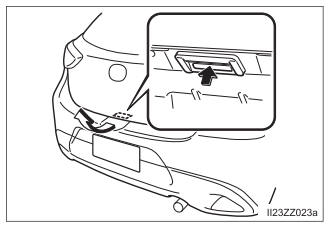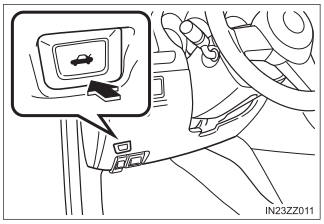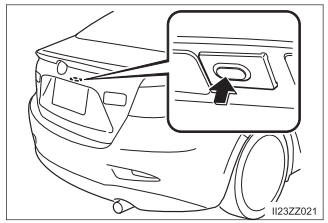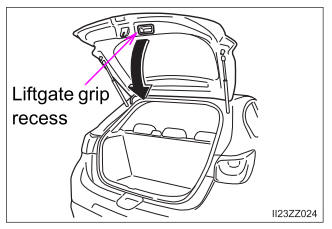Toyota Yaris: Liftgate/Trunk Lid / Opening and Closing the Liftgate/Trunk Lid
Opening the liftgate (5-Door)
Using the electric liftgate opener Unlock the doors and liftgate, then press the electric liftgate opener on the liftgate and raise the liftgate when the latch releases.

Opening the liftgate (With the advanced keyless function)
- A locked liftgate can also be opened while the key is being carried.
- When opening the liftgate with the doors and the liftgate locked, it may require a few seconds for the liftgate latch to release after the electric liftgate opener is pressed.
- The liftgate can be closed when the doors are locked with the key left in the vehicle. However, to prevent locking the key in the vehicle, the liftgate can be opened by pressing the electric liftgate opener. If the liftgate cannot be opened despite doing this procedure, first push the liftgate completely closed, then press the electric liftgate opener to fully open the liftgate.
- When the liftgate latch is released by pressing the electric liftgate
opener,
the liftgate raises slightly. If the liftgate is not operated for a certain
period of
time, the liftgate cannot be raised.
To open
Press the electric liftgate opener again.
To close
To close the liftgate from its slightly raised position, open it first by pressing the electric liftgate opener, then close it after waiting at least 1 second.
- If the liftgate is not fully closed, the driver is notified by a warning indicated in the instrument cluster.
- If the vehicle battery is dead or there is a malfunction in the electrical
system
and the liftgate cannot be unlocked, the liftgate can be opened by perform-
ing the emergency procedure.
Refer to When Liftgate/Trunk Lid Cannot be Opened.
Opening the trunk lid (4-Door)
- Using the remote release button
Push the remote release button.

- Using the electric trunk lid opener (With the advanced keyless
function)
A locked trunk lid can also be opened while the key is being carried.
Press the electric trunk lid opener on the trunk lid, then raise the trunk lid when the latch releases.

Closing the liftgate/trunk lid
5-Door
Lower the liftgate slowly using the liftgate grip recess, then push the liftgate closed using both hands. Do not slam it. Pull up on the liftgate to make sure it is secure.

4-Door
Use both hands to push the trunk lid down until the lock snaps shut. Do not slam it. Pull up on the trunk lid to make sure it is secure.
Opening the trunk lid
- When opening the trunk lid with the doors locked, it may require a few seconds for the trunk lid latch to release after the electric trunk lid opener is pressed.
- The trunk lid can be closed when the doors are locked with the key left in the vehicle. However, to prevent locking the key in the vehicle, the trunk lid can be opened by pressing the electric trunk lid opener. If the trunk lid cannot be opened despite doing this procedure, press the electric trunk lid opener to fully open the trunk lid after pushing the trunk lid completely closed.
- If the vehicle battery is dead or there is a malfunction in the
electrical system
and the trunk lid cannot be unlocked, the trunk lid can be opened by
performing the emergency procedure.
Refer to When Liftgate/Trunk Lid Cannot be Opened.
 Liftgate/Trunk Lid
Liftgate/Trunk Lid
WARNING
Never allow a person to ride in the luggage compartment/trunk
Allowing a person to ride in the luggage compartment/trunk is
dangerous.
The person in the luggage compartment/trunk could be seriously injured or
killed during sudden braking or a collision...
 Luggage Compartment
Luggage Compartment
Luggage compartment cover (5-Door)
The luggage compartment can
be accessed by opening the liftgate when the straps are
attached to the sides of the liftgate...
Other information:
Toyota Yaris XP210 (2020-2026) Reapir and Service Manual: Installation
INSTALLATION PROCEDURE 1. INSTALL NO. 2 EQUALIZER STEREO COMPONENT BRACKET (a) Engage the guides to install the No. 2 equalizer stereo component bracket. (b) Install the 2 bolts. Torque: 4.5 N·m {46 kgf·cm, 40 in·lbf} 2. INSTALL NO...
Toyota Yaris XP210 (2020-2026) Reapir and Service Manual: Disassembly
DISASSEMBLY CAUTION / NOTICE / HINT NOTICE: When using a vise, place aluminum plates between the part and vise. When using a vise, do not overtighten it. HINT: Use the same procedure for the RH side and LH side. The following procedure is for the LH side...
Categories
- Manuals Home
- Toyota Yaris Owners Manual
- Toyota Yaris Service Manual
- Battery Monitor Module General Electrical Failure (P058A01)
- To Set Speed
- Immobilizer System
- New on site
- Most important about car
Supplemental Restraint System (SRS) Precautions
The front and side supplemental restraint systems (SRS) include different types of air bags. Please verify the different types of air bags which are equipped on your vehicle by locating the “SRS AIRBAG” location indicators. These indicators are visible in the area where the air bags are installed.
The air bags are installed in the following locations:
The steering wheel hub (driver air bag) The front passenger dashboard (front passenger air bag) The outboard sides of the front seatbacks (side air bags) The front and rear window pillars, and the roof edge along both sides (curtain air bags)